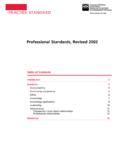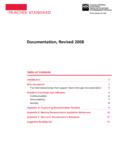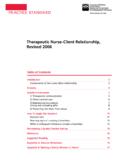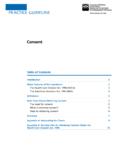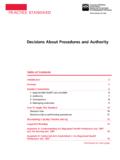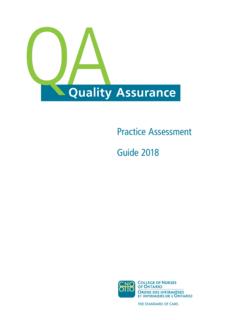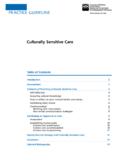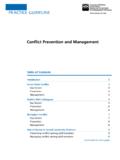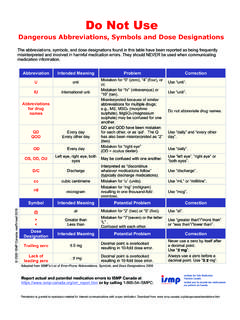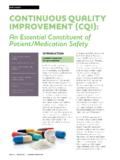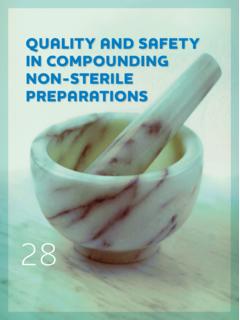Transcription of PRACTICE STANDARD Medication - CNO
1 PRACTICE STANDARDT able of Contents Introduction 3 Authority 3 Competence 3 Safety 3 Decision Tree: Is the Order Clear, Complete and Appropriate?
2 4 Decision Tree: Deciding About Medication Administration 5 Decision Tree: Deciding About Dispensing 6 Glossary 7 References 8 MedicationRevised 2017 Medication Pub. No. 41007 ISBN 978-1-77116-078-0 Copyright College of Nurses of Ontario, or for-profit redistribution of this document in part or in whole is prohibited except with the written consent of CNO. This document may be reproduced in part or in whole for personal or educational use without permission, provided that: Due diligence is exercised in ensuring the accuracy of the materials reproduced; CNO is identified as the source.
3 And The reproduction is not represented as an official version of the materials reproduced, nor as having been made in affiliation with, or with the endorsement of, published November 1996 as Medication Administration standards Reprinted January 2000, October 2000, October 2002 Revised June 2003 as Medication standards (2003) (ISBN 1-894557-33-6), Reprinted as Medication January 2004, December 2005. Revised June 2008 as Medication , Revised 2008, Updated June 2009 (ISBN 1-897308-46-9). Updated November 2011 for Bill 179 changes. Revised January 1, 2014 for Dispensing. Revised 2015 as Medication . Advance copy circulated March 2015, PRACTICE STANDARD in effect May 5, 2015.
4 Revised April 2017 for Nurse Practitioner Controlled Substances copies of this booklet may be obtained by contacting CNO s Customer Service Centre at 416 928-0900 or toll-free in Ontario at 1 800 of Nurses of Ontario 101 Davenport Rd. Toronto, ON M5R fascicule existe en fran ais sous le titre : L administration de m dicaments, no 51007 VISION Leading in regulatory excellenceMISSION Regulating nursing in the public interestPRACTICE STANDARD3 College of Nurses of Ontario PRACTICE STANDARD : MedicationIntroductionThe Medication PRACTICE STANDARD describes nurses accountabilities when engaging in Medication practices , such as administration, dispensing, Medication storage, inventory management and disposal.
5 Three principles outline the expectations related to Medication practices that promote public protection. The principles are: authority competence PRACTICE STANDARD applies to all nurses. In addition, Nurse Practitioners are accountable for the Medication practices outlined in the Nurse Practitioner PRACTICE glossary of bolded terms is provided at the end of this must have the necessary authority to perform Medication Nurses and Registered Practical Nurses require an order for a Medication PRACTICE when: a controlled act is involved administering a prescription medication1, or it is required by legislation that applies to a PRACTICE accept orders that are: clear complete appropriate.
6 Orders for Medication can be direct orders (that apply to one client) or directives (that apply to more than one client); however, orders for controlled substances must be direct orders. When a nurse receives a Medication order that is unclear, incomplete or inappropriate, the nurse must not perform the Medication PRACTICE . Instead, the nurse must follow up with a prescriber in a timely ensure that they have the knowledge, skill and judgment needed to perform Medication practices : ensure their Medication practices are evidence-informed assess the appropriateness of the Medication PRACTICE by considering the client, the Medication and the environment know the limits of their own knowledge, skill and judgment, and get help as needed, and do not perform Medication practices that they are not competent to promote safe care, and contribute to a culture of safety within their PRACTICE environments, when involved in Medication practices .
7 Nurses: seek information from the client about their Medication , as needed provide education to the client regarding their Medication collaborate with the client in making decisions about the plan of care in relation to Medication practices promote and/or implement the secure and appropriate storage, transportation and disposal of Medication promote and/or implement strategies to minimize the risk of misuse and drug diversion take appropriate action to resolve or minimize the risk of harm to a client from a Medication error or adverse reaction report Medication errors, near misses or adverse reactions in a timely manner, and collaborate in the development, implementation and evaluation of system approaches that support safe Medication practices within the health care Medications requiring a prescription can be found in the Health Canada Drug Product For example, for client treatments and diagnostic procedures, the Public Hospitals Act, regulation 965 requires an order from an identified practitioner, such as a Nurse Practitioner or a physician.
8 PRACTICE STANDARD4 College of Nurses of Ontario PRACTICE STANDARD : MedicationDecision Tree: Is the Order Clear, Complete and Appropriate?Is the order clear?Is the order complete?Is the order appropriate?The order is clear, complete and not perform and follow up with a not perform and follow up with a not perform and follow up with a : Is the order appropriate considering the client, and the client s current condition, health history, Medication history, and other medications that the client is currently taking?Consider: Does the order contain all of the information that I need to administer or dispense the Medication safely?
9 Consider: Do I understand the order?YESNONONOYESYESPRACTICE STANDARD5 College of Nurses of Ontario PRACTICE STANDARD : MedicationDecision Tree: Deciding About Medication AdministrationAre proper authorizing mechanisms in place?For example, direct order or directiveDo you have the competence to administer?For example, your knowledge of Medication , skills to administer, judgment to identify and respond to outcomesHave you assessed environmental supports? For example, human and technological resources to monitor and intervene if needed, systems in place to support safe Medication administration Have you assessed client factors?
10 For example, identify client, assess appropriateness, verify consentAdminister medicationEvaluate outcomesIf an adverse reaction occurs, take appropriate actionDo not administer medicationTake appropriate action to safeguard client interest and ensure continued care; for example, follow up with prescriberYESNONONONOYESYESYESNote: Document during and/or after administering Medication , according to the Documentation PRACTICE STANDARD6 College of Nurses of Ontario PRACTICE STANDARD : MedicationDecision Tree: Deciding About DispensingAre proper authorizing mechanisms in place?For example, direct order or directiveDo you have the competence to dispense?
